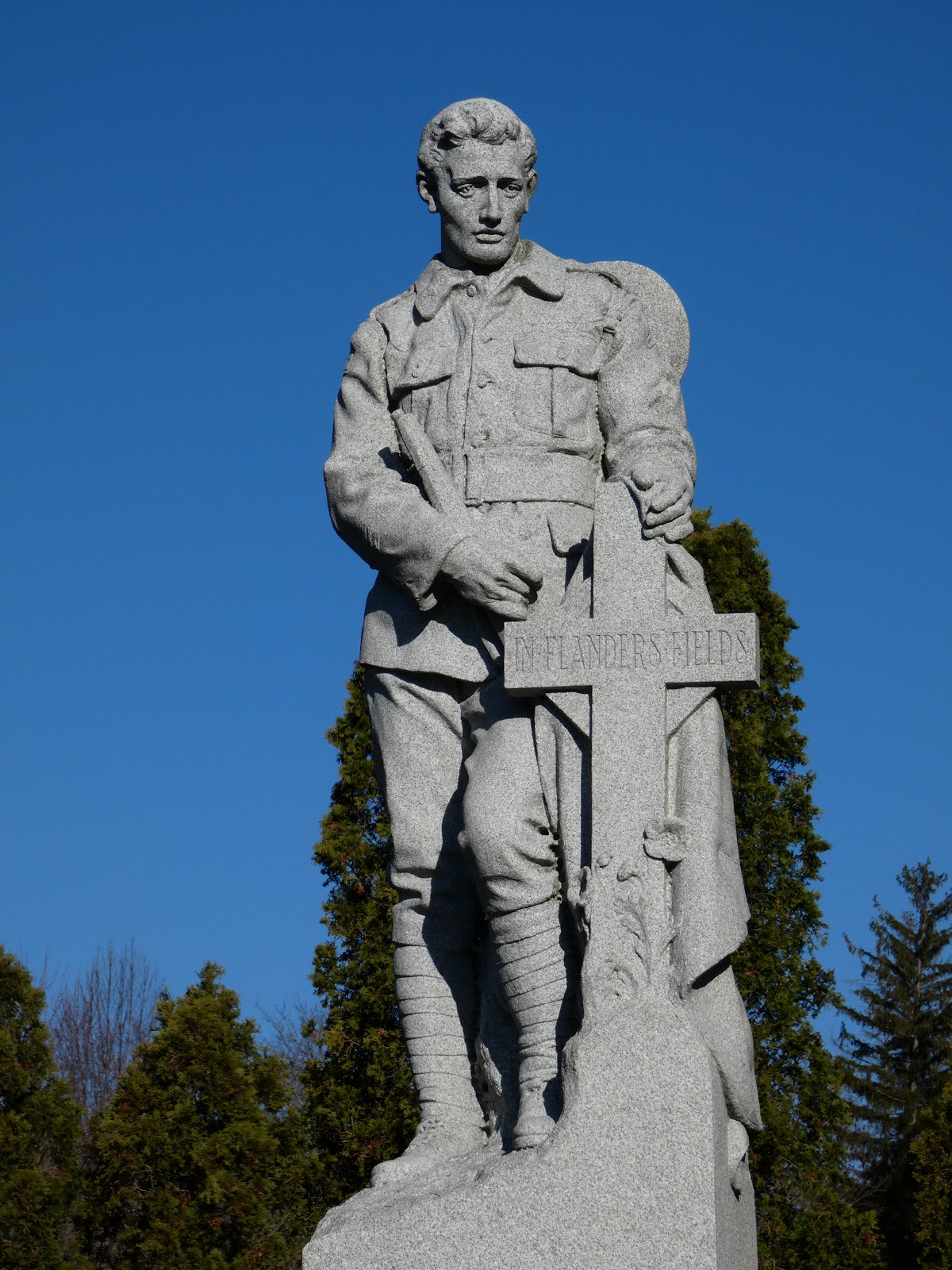The Bolton Cenotaph was unveiled on October 21, 1921, in the presence of a large crowd, including many Veterans of the Great War. With solemn and fitting ceremony the memorial was erected in honour of the fallen heroes and of those who carried on in the Great War.
When all had assembled at the cemetery, the chairman, Reeve D.B. Kennedy, of Bolton called on Rev. R.B. Beynon to open the ceremony with prayer. Mrs. Peter Munro, of Albion, who lost two sons in the war, was then asked to unveil the monument, and as the ties were released and the large flags fell away, exposing the monument to public gaze, Heggie Herbert, late bugler in the 126th Peel Battalion, sounded the Last Post. Several mothers who had lost their sons in the war, came forward and laid wreaths and flowers on the cenotaph. The school children marched past in two lines and reverently deposited their bouquets. Among the floral offerings was a beautiful wreath, donated by the Dale Estate of Brampton.
The chairman explained that the committee had seen fit to include among the names on the monument, not only those who were living here at the time of their enlistment, but also the sons of local families who joined the colours at other points, as well as a few who had spent their early days amongst us. A sealed jar, deposited in the foundation of the memorial, contained the names of all the men from this district who served during the war, also the names of the committee and other data usually recorded in this manner.
An adjournment was made to the rink where speeches were delivered by Rev. P.N. Knight, Anglican minister of Bolton, Samuel Charters, M.P., Major Kennedy, M.P.P., W.J. Lowe, Herbert Taylor, Rev. J.P. Treacy, of Toronto, John Anderson and Wm. N. Riddell, and deputy-reeve respectively, of Albion township. The speakers, one and all, paid eloquent and sincere tribute to the heroism and patriotism of the men who laid down their lives while fighting on our behalf on the battle fields of Flanders, and complimented the people of the district on erecting the memorial to their memory. Fitting reference was also made to the service rendered our country by the other brave lads who took part in the great struggle but were fortunate enough to return.
The committee in charge of the erection of the memorial was composed of the following: Robert Smith, chairman; Bert Mellow, secretary-treasurer; T.J. Roe, Thomas Cooke, Anson McCabe, Isaac Steele, Charles H. Rutherford, D.B. Kennedy, George Downey, Ernerson Westlake, J.A. Wilkie, John Cairns, Albert Robinson, John Lake and F. N. Leavens. Among those who were expected to speak at the unveiling but who were prevented by the inclement weather were Rev. Canon Cody, Hon. Edmund Bristol, Hon. R.H. Grant and Hon. Manning Doherty.
The cenotaph was located immediately inside the present main entrance to Laurel Hill Cemetery, on the left side of the road, where it remained undisturbed for almost half century. In 1969, it was moved to the south end of Centennial Drive near Queen Street.
The cenotaph was designed and erected by the Thompson Monument Company of Toronto. Constructed of Canadian granite, the memorial is admitted to be a work of art, and conveys a story full of meaning. In front is the sarcophagus on which lie a rifle, bayonet, helmet and belt of a private soldier, the whole entwined with laurel leaves. The shaft contains on front and back the names of fifty-six fallen heroes, arranged according to the date of their death. The committee has recognized the fact that death has eliminated all distinctions, therefore no rank of the fallen men is recorded.
The shaft is supported on each side by the Altar of Sacrifice. Emanuel Hahn's statue design represents the sorrows caused by war. The soldier atop the cenotaph looks down in sadness at the ground below him, as if he might find there, his fallen comrades, if not for the tragedy of war. The statue depicts a young, grieving Canadian soldier in First World War army uniform. With uncovered head, he is standing at a battlefield grave – a simple cross with poppies at the base – the final resting place of a comrade killed in action. His left hand rests on the cross, while his right hand holds a reversed rifle. His whole attitude expressive of reverent yet manly courage as he views the bier of his fallen comrade. Around the base is engraved the names of 21 battles, from Ypres to Mons.
Emanuel Hahn moved to Toronto at the age of seven with his family of artists and musicians from Germany, in 1888. He studied commercial design and model-making at Toronto Technical School and Ontario College of Art and Industrial Design. At 25 years old Hahn began a nearly lifelong contract with Thomson Monument Company of Toronto. Two years later, he also started work as a studio assistant to sculptor Walter Seymour Allward. Part of his duties included assisting on Allward’s significant works such as the South African War Memorial in Toronto.
In 1912 Hahn began an association with the Thomson Monument Company of Toronto. It was there, along with several assistants, he made the many war memorials that are found across Canada: Fernie, British Columbia; Killarney and Russell, Manitoba; Alvinston, Bolton, Cornwall, Hanover, Lindsay, Malvern, Milton, Petrolia and Port Dalhousie, Ontario; Gaspe, Quebec; Moncton, New Brunswick; Springhill and Westville Nova Scotia; Summerside, Prince Edward Island.
Hahn is probably most famous as the designer of the Bluenose on the back of the Canadian dime and the Caribou on the back of the Canadian quarter. He was a victim of anti-German sentiment in the years following the Great War, when his design for the Winnipeg Cenotaph was rejected in 1925.



